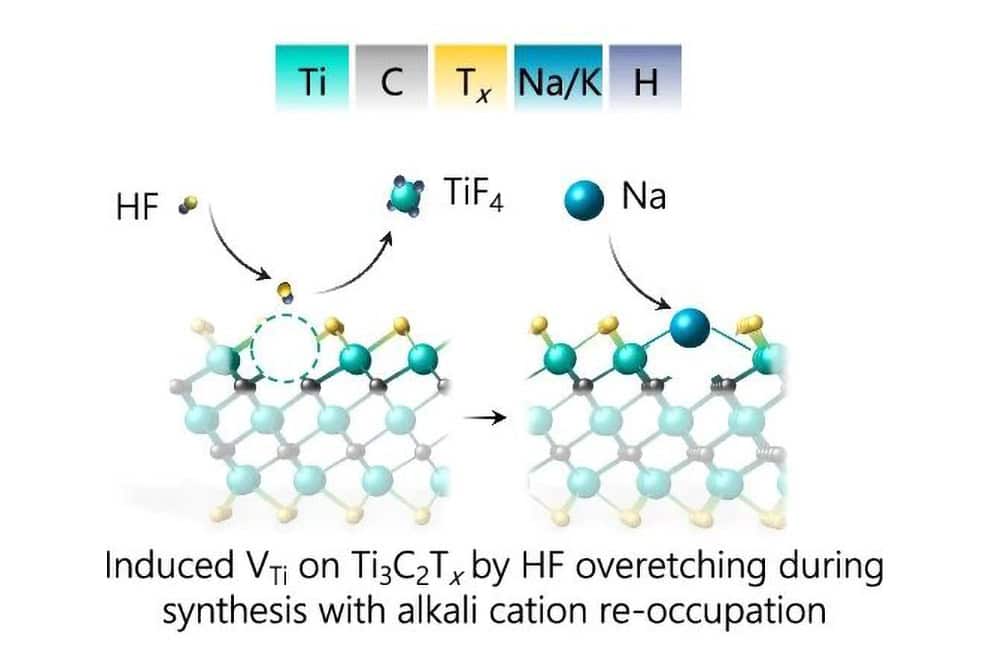
[Image above] Illustration showing the use of a highly acidic etching mixture to induce the formation of more defects in the MXene surface, after which alkali cations are used to fill the vacancy sites. Credit: Wyatt et al., Nature Communications (CC BY-NC-ND 4.0)
For homeowners, a common adage is that duct tape and WD-40 can solve almost any problem. For materials scientists, it is becoming more and more likely that MXenes will fulfill that same fixer role across multiple different industrial sectors.
MXenes are an ever-expanding field of 2D transition metal carbides and nitrides. As a derivative of the well-known class of bulk layered ternary carbides and nitrides called MAX phases, MXenes demonstrate a wide range of chemical and structural diversity. This diversity leads to a range of impressive material behaviors, including electrical conductivity (up to 24,000 S/cm), mechanical stiffness (up to 484 ± 13 GPa), and solution processibility, among other properties.
This array of behaviors allows MXenes to serve in applications ranging from electrocatalysis to electromagnetic interference shielding to water treatment. Researchers anticipate these materials will find application in many more areas as well.
Ultrahigh-temperature environments, such as the leading edges of hypersonic vehicles, are the next sector that researchers are exploring as a potential application area for MXenes. Although MXenes display detrimental oxidation behavior in water or oxygen-containing environments, carbide MXenes form ultrahigh-temperature nanolamellar structures that are highly stable in inert high-temperature environments (shown up to 1,500°C).
Of course, achieving this high-temperature stability is dependent on fabricating a pristine nanolamellar structure. But that can be difficult due to how MXenes are typically synthesized.
In contrast to other 2D materials, which are built up atom-by-atom from reactive gases, MXenes are produced via a top-down synthesis process, which involves selectively etching MAX phases until only the MXenes are left. This process requires the use of harsh chemicals, such as hydrofluoric acid, which not only breaks the chemical bonds between layers but can also leave behind holes (defects) in the MXene structure.
“Because these materials are so small, when even the tiniest part of the MXene flakes away, it leaves an imperfect defective surface which significantly affects its stability. Every atom matters,” says Brian Wyatt, a Ph.D. student at Purdue University, in a Purdue University press release.
To address this challenge, Wyatt and others in the group of Babak Anasori, Reilly Rising Star associate professor of materials and mechanical engineering at Purdue University, investigated the possibility of using simple alkali chloride salts to fill in the holes caused by the acid etching process.
As explained in their open-access paper, the researchers knew from existing literature on MXene battery research that alkali cations can effectively shuttle between MXene interlayers and bind with the material’s surface. However, exact interactions of these cations with the MXene surface—for example, if they prefer to bind with surface groups or occupy the transition metal atomic vacancy sites—were not fully understood.
To better understand these interactions, the Purdue researchers increased the acidity of the etching mixture to induce more defects in the resulting MXene. They then stirred the MXene in an alkali chloride salt solution and observed where the cations latched onto the MXene surface using dynamic atomic-resolution layer-by-layer secondary ion mass spectrometry.
The researchers discovered that the alkali cations preferred to occupy vacancy sites on the MXene surface rather than bind with the surface groups. This discovery led to experiments on the high-temperature phase behavior of the salt-filled MXenes, and these tests revealed that the cations did improve the MXene’s structural stability.
Further experimentation with thicker films and more complex MXene compositions confirmed this finding. Though more studies are needed to confidently generalize this behavior to all MXene systems, “Overall, this study establishes the use of alkali metal cations as defect engineering techniques to control the phase stability of 2D MXenes in ambient and high temperatures,” the researchers conclude.
The open-access paper, published in Nature Communications, is “Alkali cation stabilization of defects in 2D MXenes at ambient and elevated temperatures” (DOI: 10.1038/s41467-024-50713-2).
